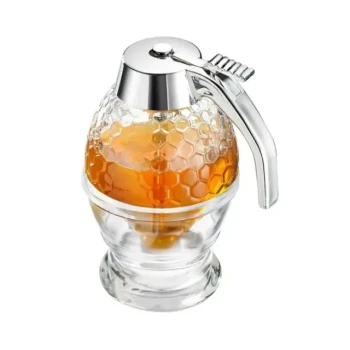Moisture content is the single most critical factor determining honey's stability and quality. Excess water, typically above 19%, allows naturally present yeasts to thrive, leading to fermentation that spoils the honey's flavor and aroma. This directly impacts its shelf life, usability, and commercial value.
The core challenge is a balancing act: honey must have enough moisture to remain liquid but not so much that it ferments. Achieving the ideal moisture content—between 17% and 18%—is the primary goal for preventing spoilage and preserving the honey's integrity.

The Primary Risk: Fermentation and Spoilage
The most severe consequence of high moisture content is the degradation of the honey itself through a natural biological process.
What is Fermentation?
Honey contains natural yeasts. When the water content is too high, these dormant yeasts become active and begin to consume the honey's sugars. This process produces alcohol and carbon dioxide, giving the honey a sour, "off" taste and smell, effectively spoiling it.
The Critical Threshold
The industry standard for high-quality honey is a moisture level below 20%, with the ideal range being 17% to 18%. Once moisture levels exceed 19%, the risk of fermentation increases dramatically.
Downgraded Product
Honey that has fermented is no longer suitable for consumption as table honey. It is often downgraded to "baker's honey," a lower-quality product used for industrial purposes, which significantly reduces its market value.
Beyond Spoilage: Secondary Quality Issues
Even if fermentation hasn't fully occurred, excess moisture can introduce other undesirable characteristics.
Increased Granulation
While granulation (crystallization) is a natural process, honey with high water content can sometimes granulate more readily, affecting its texture and consumer appeal.
Handling and Packaging Challenges
Excess moisture makes honey less viscous and more "sticky." This can create difficulties during processing and bottling, causing the product to adhere to packaging and making it harder to handle and dispense cleanly.
Common Causes of High Moisture
Understanding the source of excess moisture is the first step toward controlling it. Several factors can contribute to this problem.
Environmental Factors
Bees produce honey in environments with varying humidity. A particularly wet spring or a humid climate can result in honey with naturally higher water content.
Premature Harvesting
This is a critical error in beekeeping. If honey is harvested from the comb before the bees have had a chance to dehydrate it to the proper level (and cap the cells with wax), it will inherently have too much moisture.
Contamination During Extraction
Water can be accidentally introduced during the honey extraction and bottling process. Inadequate cleaning and drying of equipment is a common source of this contamination.
How to Control Honey Moisture
For producers, actively managing moisture is a non-negotiable part of quality control.
Accurate Measurement is Key
The most reliable tool for measuring moisture content is a refractometer. This device provides a quick and precise reading, allowing beekeepers and processors to verify the quality of their honey before it is bottled.
Methods for Moisture Reduction
If honey is found to have high moisture content, it can be reduced. Common methods include gently heating the honey or using a dehumidifier in a closed room to slowly draw excess water out of the stored honey over several days.
Making the Right Choice for Your Goal
Your approach to moisture content depends entirely on your role in the honey's journey from hive to table.
- If your primary focus is beekeeping: Harvest only fully capped frames of honey and invest in a refractometer to test every batch before extraction.
- If your primary focus is processing and bottling: Standardize your process by testing all incoming honey and using controlled dehumidification to ensure every batch is within the ideal 17-18% range.
- If your primary focus is consumption: A sour or alcoholic smell is the clearest sign of fermented, low-quality honey due to excessive moisture.
Ultimately, managing moisture is the defining practice that protects the value and preserves the natural quality of honey.
Summary Table:
| Moisture Level | Impact on Honey Quality | Risk Level |
|---|---|---|
| Below 17% | Excellent stability, ideal for long-term storage | Low |
| 17% - 18% | Optimal range, prevents fermentation | Very Low |
| 19% - 20% | Increased fermentation risk, shorter shelf life | Moderate |
| Above 20% | High spoilage risk, downgraded to baker's honey | High |
Protect Your Honey's Quality and Profitability
For commercial apiaries and beekeeping equipment distributors, maintaining optimal honey moisture content is critical for product integrity and market value. HONESTBEE supplies professional-grade refractometers, honey processing equipment, and moisture control solutions to help you:
- Accurately measure moisture levels in every batch
- Prevent fermentation and spoilage losses
- Maintain consistent, high-quality honey production
- Maximize your product's shelf life and commercial value
Ready to upgrade your quality control process? Contact our wholesale experts today to discuss equipment solutions tailored for your operation.
Visual Guide

Related Products
- Precision Honey Refractometer Instrument for Quality Assessment
- Professional Thermostatic Conical Honey Melter
- Honey Concentrating Vacuum Heating Thickening Machine Dehumidifier for Honey
- electric honey extractor honey centrifuge 3 frame honey extractor stainless steel honey frame extractor
- HONESTBEE 3-Frame Manual Acrylic Honey Extractor
People Also Ask
- Why is a honey refractometer important for beekeepers? Ensure Quality and Prevent Fermentation
- Why is a honey refractometer considered essential for commercial beekeepers? Ensure Honey Quality and Profitability
- Why is a honey refractometer essential for honey harvesting? Protect Your Harvest from Spoilage
- What are the features of the Standard Refractometer for honey moisture content? Essential Tools for Quality Control
- What are the key steps to using a honey refractometer? Ensure Honey Quality & Prevent Fermentation



















